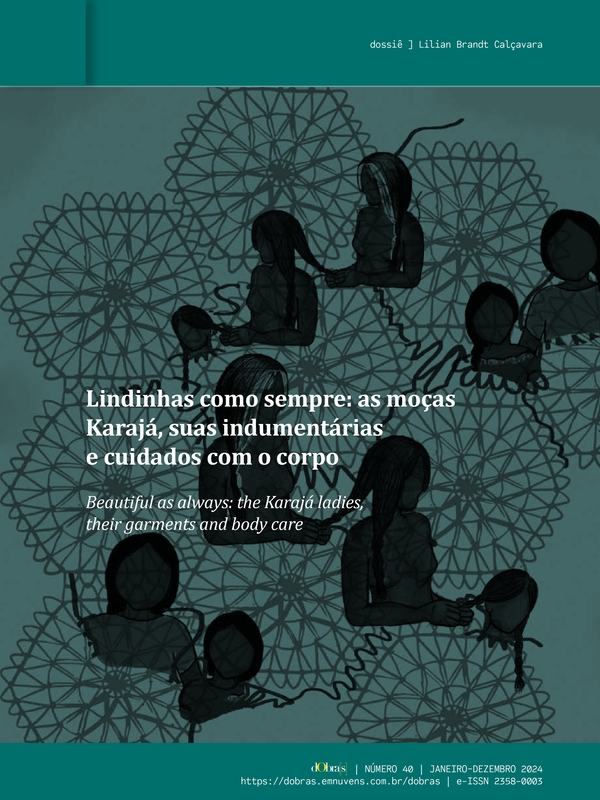Beautiful as always: the Karajá ladies, their garments and body care
DOI:
https://doi.org/10.26563/dobras.i40.1684Keywords:
Garments, Indigenous, Karajá, Lady, MarriageAbstract
In this article I present a little of the pluriverse of the Karajá girls, the ijadòkòma/ijadòma, from a collaborative perspective. I highlight two rituals that mark the beginning and the end of this phase of youth: the transition from “big girl” to young woman, from their first menstrual cycle, the menarche, and marriage, which marks the departure from the period in which one is a young woman. In both celebrations, I talk about garments, paintings and body care. I also present other themes that the ladies brought up, such as the use of cell phones and dating, seeking to contextualize in which people those garments are worn. This is an excerpt from the dissertation “Ijadòkòma itxỹtè: the Karajá girls ‘crazy’ and ‘beautiful as always’” (2019), produced within the scope of the Professional Master’s Degree in Sustainability with Traditional Peoples and Territories (ME-SPT), at the University of Brasília (UnB), with new notes added. The methodology used in the work was action research, a process in which they took the lead in the activities. In addition to the dissertation, the research resulted in two films produced by the ladies.
Downloads
References
ANDRADE, Rita Moraes de. Vestires indígenas em bonecas Karajá: argumentos para uma história. Questões & Debates, Curitiba, volume 65, n.2, p. 197-222, jul./dez. 2017. DOI: https://doi.org/10.5380/his.v65i2.55395
BRASIL. Mortalidade por suicídio na população indígena no Brasil, 2015 a 2018. Boletim Epidemiológico, Volume 51, nº37. Ed. Atual. Brasília: Ministério da Saúde, 2020.
CALÇAVARA, Lilian Brandt. “Ijadòkòma itxỹtè: as moças Karajá ‘doidinhas’ e ‘lindas como sempre’”. Dissertação (Mestrado em Desenvolvimento Sustentável junto a Povos e Terras Tradicionais – MESPT - Centro de Desenvolvimento Sustentável. Universidade de Brasília, 2019. Disponível em http://repositorio2.unb.br/jspui/handle/10482/37041. Acesso em 30 de jul. 2023.
BANIWA, Gersem. Prefácio. In: OLIVEIRA, Assis da Costa; RANGEL, Lúcia Helena (Org.). Juventudes Indígenas: Estudos interdisciplinares, saberes interculturais. Conexões entre Brasil e México. Rio de Janeiro: E-papers, 2017. p. 5-12 IBGE. Censo demográfico 2022. Indígenas – Primeiros resultados do universo. Disponível em: <https://www.aen.pr.gov.br/sites/default/arquivos_restritos/files/documento/2023-08/liv102018_1.pdf>. Acesso em 16/11/2023.
INDUMENTA. “Ixitkydkỹ: um olhar sobre os vestires tradicionais das mulheres Inỹ Karajá”. Disponível em: <https://www.vestiresmulheresinykaraja.com>. Acesso em 30/07/2023.
LAGROU, Els. Arte indígena no Brasil: agência, alteridade e relação. Belo Horizonte: C /Arte, 2009.
LIMA FILHO, Manuel Ferreira; SILVA, Telma Camargo da. A arte de saber fazer grafismo nas bonecas Karajá. Horizontes antropológicos, Porto Alegre, v. 18, n. 38, p. 45-74, Dec. 2012. Disponível em: <http://www.scielo.br/scielo.php?script=sci_arttext&pid=S0104-71832012000200003&lng=en&nrm=iso>. Acesso em 30/07/2023. http://dx.doi.org/10.1590/S0104-71832012000200003 DOI: https://doi.org/10.1590/S0104-71832012000200003
NUNES, Eduardo Soares. Transformações Karajá: Os “antigos” e o “pessoal de hoje” no mundo dos brancos. 2016. 609f. Tese (Doutorado em Antropologia Social) – Departamento de Antropologia, Universidade de Brasília, Brasília, 2016.
OLHO Filmes. Trailler Ritxoko., 2013. Disponível em: <https://www.youtube.com/watch?v=KJGDn5guH1o>. Acesso em 30/07/2023.
PORTELA, Cristiane de Assis. Nem ressurgidos, nem emergentes: a resistência histórica dos Karajá de Buridina em Aruanã – GO (1980-2006). 2006. 233. Dissertação (Mestrado em História da Faculdade de Ciências Humanas e Filosofia da Universidade Federal de
Goiás), Goiânia, 2006. SESAI – Secretaria Especial de Saúde Indígena. Plano de Ação: Saúde Mental. DSEI Araguaia, Sesai/MS, 2014.
SIASI – Sistema de Informação da Atenção à Saúde Indígena. Ministério da Saúde. Censo populacional. Dados de 20 de maio de 2019
TORAL, André Amaral. Cosmologia e sociedade Karajá. 1992.Dissertação (Mestrado em Antropologia Social). Museu Nacional/UFRJ, Rio de Janeiro, 1992.
VIVEIROS DE CASTRO, Eduardo. “Transformação” na Antropologia, transformação da “Antropologia”. Revista Mana, Rio de Janeiro, v. 18, nº 2, p. 151-171, 2012. DOI: https://doi.org/10.1590/S0104-93132012000100006
VIVEIROS DE CASTRO, Eduardo. Contra-antropologia, contra o Estado: uma entrevista com Eduardo Viveiros de Castro. Entrevista concedida a Paulo Bull. Revista Habitus, Rio de Janeiro, v. 12, nº 2, p. 146-163, 2014.

Downloads
Published
How to Cite
Issue
Section
License
Copyright (c) 2024 Lilian Brandt Calçavara

This work is licensed under a Creative Commons Attribution-NonCommercial-ShareAlike 4.0 International License.
The copyrights of the works published in this journal belong to the author, and dObra[s] holds the rights of first publication. Due to their publication in this open access journal, any work here is free to use, with its own attributions, in educational and non-commercial applications.









